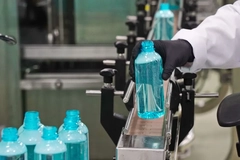Monomer migration: Scientists identify 388 hazardous packaging chemicals for high priority phase-out

07 Jun 2022 --- Plastic monomers that are known to have carcinogenic, mutagenic and toxic to reproduction (CMR) hazard properties can easily transfer into food products, making them highly relevant for human exposure, finds a new study. According to the researchers, many of these chemicals are common in European food packaging.
Published in The Journal of Hazardous Materials, the study refutes the common assumption that monomers, which serve as starting materials for manufacturing plastic polymers, do not migrate from finished food packaging into food products.
The study identifies 388 chemicals of concern that are “high priority” for a legal phase-out. These chemicals include 352 CMRs, 22 endocrine-disrupting chemicals, and 32 chemicals with persistence- and bioaccumulation-related hazards.
The findings follow a political commitment by the European Commission (EC) to place a blanket ban on thousands of potentially hazardous chemicals by 2030.
Speaking to PackagingInsights, co-study author Jane Muncke, managing director and chief scientific officer of the Food Packaging Forum, says the findings could inform legislation revolutionizing healthcare.
 Study finding of different hazerdous chemicals.“European citizens today are exposed to thousands of chemicals when they buy packaged and processed foods, and the science shows clearly that many of these chemicals are known to be hazardous and can cause harm to health – like cancers, cardiovascular diseases, obesity, diabetes, allergies, neurological problems and infertility,” she says.
Study finding of different hazerdous chemicals.“European citizens today are exposed to thousands of chemicals when they buy packaged and processed foods, and the science shows clearly that many of these chemicals are known to be hazardous and can cause harm to health – like cancers, cardiovascular diseases, obesity, diabetes, allergies, neurological problems and infertility,” she says.
Daily exposure
There is no legal requirement for manufacturers to disclose what chemicals they use in food contact materials, explains Muncke.
“Therefore, it is very difficult to estimate how common these food contact chemicals of concern are. But for some of these chemicals, we know they are extremely common: styrene is such an example, it is a probable human carcinogen and therefore a hazardous chemical as defined by The EU Chemicals Strategy for Sustainability (CSS).”
Styrene is the building block of polystyrene, a plastic that is very widely used as a food contact material in, for example, dairy products like yogurt and cottage cheese and even for hot beverages, which leads to higher and faster chemical transfer.
“There is plenty of evidence that styrene migrates from food packaging into food,” continues Muncke.
“This means that a very large part of the entire population is exposed to styrene on a daily basis. And even if the levels of exposure are low, it matters because the number of people that get exposed to this hazardous chemical is so big.”
“So, banning this chemical in food contact materials would really make a change to the number of new cancer cases that occur. The consequence of inaction is that there will be more avoidable diseases – like cancer – depending on the specific chemicals and their hazard properties.”
EU commitments
Muncke says it’s also important to note that these concerns are not new, and there have been plans at the EC for regulatory reform of food contact materials legislation for more than ten years.
.jpg) Chemicals used as grease barriers in fast food packaging have long caused concern.The EU has committed to phasing out hazardous chemicals in food contact materials in its Farm to Fork strategy and the CSS.
Chemicals used as grease barriers in fast food packaging have long caused concern.The EU has committed to phasing out hazardous chemicals in food contact materials in its Farm to Fork strategy and the CSS.
“This commitment now needs to be followed up by truthful implementation – here, our study can help by providing a list of chemicals used in the manufacture of food contact materials that are harmful as defined by the F2F and CSS. So in principle, if the EC wants to walk the talk, it could ban these chemicals in food contact materials,” Muncke asserts.
This year, the American Chemical Society found that chemical pollution has passed the threshold of a stable environment for the first time in 10,000 years, “threatening the integrity of Earth system processes.”
Industry fight back
Muncke says she expects the study's findings will likely be resisted by many industry players but insists the results could lead to important innovations.
“Of course, the findings we present here will not be welcomed by all with open arms. Some of the chemicals listed in our study are highly profitable, and business operators will not be happy just to let them go.”
“At the same time, regulating these chemicals can inspire innovation, not necessarily only in the chemicals sector (for example, to develop safer chemicals) but also in other sectors that are building new distribution models for food, for example, by favoring inert food packaging containers where the transfer of chemicals into food is strongly reduced,” she says.
“My worry is that the chemical industry is so powerful and that we will see delays to the logical action that is needed right now, namely removing these most hazardous chemicals from the market. And these delays will lead to diseases, despite the fact that they are avoidable. This human toll will be on the conscience of those actors who are delaying the necessary action.”
By Louis Gore-Langton











